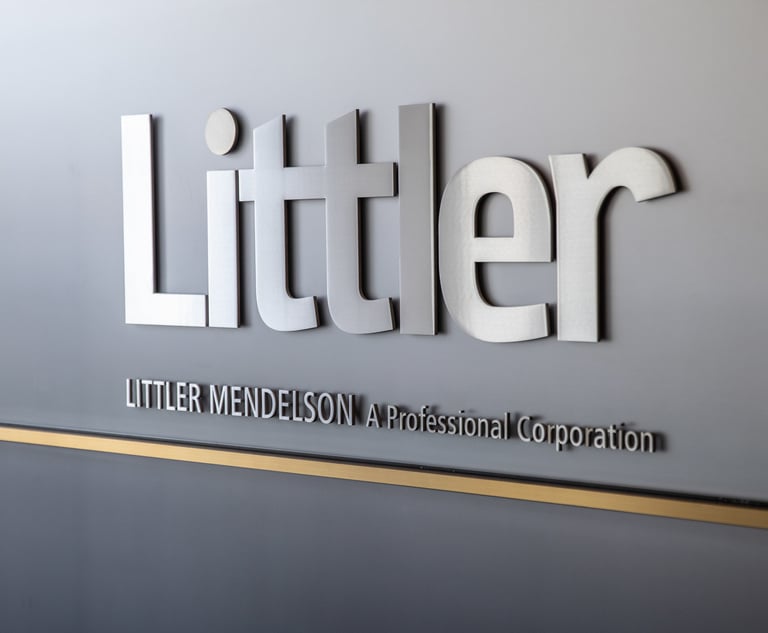After a Strong First Quarter, Citi Says Firms Are Focused on Cash Flow
Median projections of 15% declines in second-quarter demand and revenue are partially driven by an estimated 11% lengthening of the collection cycle.
May 13, 2020 at 03:45 PM
7 minute read
 Image: Shutterstock
Image: Shutterstock
2020 may have started off strong for the law firm industry, but discussing the first-quarter results in the midst of the COVID-19 pandemic feels like writing a history paper. There were a number of positive signs of what this year could have been. We saw a trifecta of strong demand, rate and revenue growth. We also saw modest expense growth—in stark contrast to the first quarter of 2019. However, as we inch toward the mid-point of the second quarter, we know that firms find themselves in a much different environment.
These results are based on a sample of 187 firms (74 Am Law 100 firms, 53 Second Hundred firms and 60 niche/boutique firms). Forty of these firms fit our definition of either international (less than 25% but more than 10% of lawyers based outside the United States) or global (at least 25% of lawyers based outside the United States). Citi Private Bank provides financial services to more than 700 U.S. and U.K. law firms and more than 50,000 individual lawyers. Each quarter, the Law Firm Group confidentially surveys firms in the Am Law 100 and the Second Hundred, along with smaller firms. In addition, we conduct a more detailed annual survey and semiannually produce the Law Firm Leaders Confidence Index. These reports, together with extensive discussions with law firm leaders, provide a comprehensive overview of current financial trends in the industry, as well as forward-looking insight.
Revenue growth of 6.5% during the first quarter was driven by a combination of 5.3% lawyer billing rate growth, 2.6% demand growth, and collecting on the strong year-end inventory we reported for 2019. At 7.1% year-end 2019 inventory growth, we had projected a strong start to 2020, and heard anecdotally that collections were strong, particularly in the early part of this first quarter. Even so, we continued to see the collection cycle lengthen during the first quarter, by 0.9%. While this may have dampened first-quarter collections, it helped drive first-quarter inventory growth of 7.4%. The question now is how much firms can collect on that inventory in this challenging environment.
Expenses were up 3.9% for the first quarter, trailing revenue growth, and much better than the strong expense pressure we saw during the same period in 2019. There was continued compensation expense pressure, growing 5.4%, but lawyer head count did grow a solid 2.2%. On the other hand, a modest 2.6% increase in operating expenses helped control overall expense growth. We had heard about some prepayment of 2020 expenses in 2019, providing a degree of relief in these first-quarter results.
While lawyer head count grew 2.2%, equity partner head count was marginally down, continuing the longstanding trend of careful equity partner head count management. As a result, lawyer leverage was up by 3%. And with demand growth outpacing lawyer head count growth, we saw average lawyer productivity improve by 0.3%–another positive sign of what this year could have been.
However, since mid-March, we have been operating in a very different environment. Through regular surveys we have conducted with clients across the industry, we saw early median projections of 15% declines in second-quarter demand and revenue, the latter partially driven by an estimated 11% lengthening of the collection cycle.
Through our surveys and regular conversations with clients, we see that firms are understandably very focused on cash flow management. The first-quarter results helped, but firms now face declining demand and revenue, while expenses continue to mount. To retain cash, we have seen firms withhold outstanding partner distributions, especially given the postponement of the tax deadline. While still not a majority, a significant number of firms have reduced or delayed monthly partner draws. Many have also drawn down on their lines of credit. Some have delayed return of partner capital.
Firms have also become even more focused than usual on recording time, sending bills and collecting. Some describe this as an important liquidity lever within partners' control. While there is sensitivity around clients' ability to pay, firms describe the expense pressures they face and the need to keep an eye on their ability to cover those expenses.
To manage expenses, firms have introduced hiring freezes and reduced the use of temp and contract staff and consultants. Some have furloughed support staff, typically in small numbers, and often where the roles required onsite work. We have started to see more firms instituting lawyer and staff salary reductions, though this remains in the minority for now. Firms have reviewed upcoming major capital investments, deciding what can be delayed or suspended for the time being. And then there are the expense reductions naturally created by the cancellation of travel and events.
With the move to remote working, we have also seen firms delay and shorten their summer programs. That said, many have told us that they will pay summer associates the same amount, regardless of the program's duration. Some have also either delayed the start date of their fall associate class, or are considering it, depending on the bar exams. This may create a 2020 expense save for firms that delay the start date.
Looking at activity levels across practice areas, clients tell us that some have remained or have become increasingly active since this crisis unfolded, while others are having a different experience. Bankruptcy and financial restructuring, finance, government relations and labor and employment practices are busy. On the other hand, M&A/corporate/transactional practices, the primary driver of demand growth for the past several years, have seen a slowdown, as have capital markets, real estate and IP. Litigation has been mixed. Some report a slowdown. Others report high activity levels, though have noted some softness.
There is no doubt that firms are facing unprecedented challenges. That said, there are a number of positive trends we have seen emerge during this time of sudden and massive change forced on all of us. We have witnessed the rapid and successful move to mass remote working. Through an array of videoconferencing tools, developing new intranet sites and websites, partnering with clients and the broader community on pro bono efforts and simply making more phone calls, firms describe how they have been able to maintain a strong culture and stay connected to clients. Many have described how this crisis has brought them even closer to clients, and engendered a greater sense of community across practices and offices.
We are now at a point where firms are beginning to plan for a return to the office. Many note that it will take time, and require a phased approach. They describe how it was much easier to go remote than it will be to come back to the office. Firms are balancing advice from state and local authorities with the readiness of their people to return to the office. No doubt some of the changes forced upon us will become permanent, at least in part. We now know that mass remote working is feasible. What that means in the longer term for office space, technology and business travel is something we will watch with great interest.
2020 may have started strong, but we are now in an unanticipated recession and the landscape looks very different for law firms in this second quarter and beyond. We anticipate that first-half results will be challenging. Managing cash flow—from recording time to collecting on inventory to managing expenses—will be key. And as we hear from many law firms, so will staying close to clients and finding ways to bring value to them in these unprecedented and troubling times.
Gretta Rusanow is managing director and head of advisory services within Citi Private Bank's Law Firm Group.
This content has been archived. It is available through our partners, LexisNexis® and Bloomberg Law.
To view this content, please continue to their sites.
Not a Lexis Subscriber?
Subscribe Now
Not a Bloomberg Law Subscriber?
Subscribe Now
NOT FOR REPRINT
© 2025 ALM Global, LLC, All Rights Reserved. Request academic re-use from www.copyright.com. All other uses, submit a request to [email protected]. For more information visit Asset & Logo Licensing.
You Might Like
View All

Three Akin Sports Lawyers Jump to Employment Firm Littler Mendelson

Brownstein Adds Former Interior Secretary, Offering 'Strategic Counsel' During New Trump Term
2 minute read
Trending Stories
Who Got The Work
J. Brugh Lower of Gibbons has entered an appearance for industrial equipment supplier Devco Corporation in a pending trademark infringement lawsuit. The suit, accusing the defendant of selling knock-off Graco products, was filed Dec. 18 in New Jersey District Court by Rivkin Radler on behalf of Graco Inc. and Graco Minnesota. The case, assigned to U.S. District Judge Zahid N. Quraishi, is 3:24-cv-11294, Graco Inc. et al v. Devco Corporation.
Who Got The Work
Rebecca Maller-Stein and Kent A. Yalowitz of Arnold & Porter Kaye Scholer have entered their appearances for Hanaco Venture Capital and its executives, Lior Prosor and David Frankel, in a pending securities lawsuit. The action, filed on Dec. 24 in New York Southern District Court by Zell, Aron & Co. on behalf of Goldeneye Advisors, accuses the defendants of negligently and fraudulently managing the plaintiff's $1 million investment. The case, assigned to U.S. District Judge Vernon S. Broderick, is 1:24-cv-09918, Goldeneye Advisors, LLC v. Hanaco Venture Capital, Ltd. et al.
Who Got The Work
Attorneys from A&O Shearman has stepped in as defense counsel for Toronto-Dominion Bank and other defendants in a pending securities class action. The suit, filed Dec. 11 in New York Southern District Court by Bleichmar Fonti & Auld, accuses the defendants of concealing the bank's 'pervasive' deficiencies in regards to its compliance with the Bank Secrecy Act and the quality of its anti-money laundering controls. The case, assigned to U.S. District Judge Arun Subramanian, is 1:24-cv-09445, Gonzalez v. The Toronto-Dominion Bank et al.
Who Got The Work
Crown Castle International, a Pennsylvania company providing shared communications infrastructure, has turned to Luke D. Wolf of Gordon Rees Scully Mansukhani to fend off a pending breach-of-contract lawsuit. The court action, filed Nov. 25 in Michigan Eastern District Court by Hooper Hathaway PC on behalf of The Town Residences LLC, accuses Crown Castle of failing to transfer approximately $30,000 in utility payments from T-Mobile in breach of a roof-top lease and assignment agreement. The case, assigned to U.S. District Judge Susan K. Declercq, is 2:24-cv-13131, The Town Residences LLC v. T-Mobile US, Inc. et al.
Who Got The Work
Wilfred P. Coronato and Daniel M. Schwartz of McCarter & English have stepped in as defense counsel to Electrolux Home Products Inc. in a pending product liability lawsuit. The court action, filed Nov. 26 in New York Eastern District Court by Poulos Lopiccolo PC and Nagel Rice LLP on behalf of David Stern, alleges that the defendant's refrigerators’ drawers and shelving repeatedly break and fall apart within months after purchase. The case, assigned to U.S. District Judge Joan M. Azrack, is 2:24-cv-08204, Stern v. Electrolux Home Products, Inc.
Featured Firms
Law Offices of Gary Martin Hays & Associates, P.C.
(470) 294-1674
Law Offices of Mark E. Salomone
(857) 444-6468
Smith & Hassler
(713) 739-1250









